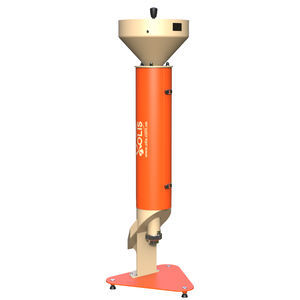

- Company
- Products
- Catalogs
- News & Trends
- Exhibitions
Sample grain sampler Storehouse
Add to favorites
Compare this product
Characteristics
- Options
- sample
Description
Storehouse trier grain sampler is designed for operational spot sampling of grain from a bulk of grain in storages and warehouses.
It is used in grain receiving and grain processing enterprises, feed mills, oil extraction enterprises and inspection companies.
The probe consists of a removable long rod and a transverse handle. In turn, the design of the grain intake includes: the cylindrical container with a hole in its upper part for pouring grain; the conical point with a smooth surface, which facilitates the insertion of the probe to the required depth by pushing the grains apart; the valve that protects the container from getting grain into it while the sampler is immersed in the depth of the embankment.
To take a point sample, the probe with a closed valve (it closes automatically due to the pressure exerted by the layer of grain) is immersed into the grain, at the required depth. The intake valve is opened with a short sampler upward movement and the container is filled for a certain time.
For the correct formation of the sample, grain sampling must be carried out at different levels and in different places of the embankment, while the sampler must be immersed without backward jerks in order to avoid premature opening of the intake openings in other layers of the embankment.
Collapsible connection in the middle of the rod allows the sampler to be assembled for easy storage and transportation.
Specifications
Type - manual
Material - metal
Length with/without handle, mm - 3060/2820
Diameter, mm - 40
Sampling depth, mm - 2600
Net weight (without handle), kg - 4,6
Catalogs
No catalogs are available for this product.
See all of OLIS‘s catalogsRelated Searches
- Grain analyzer meter
- Benchtop analyzer meter
- Grain sampler
- °C thermometer
- Digital thermometer
- Flour analyzer
- Probe thermometer
- °F thermometer
- Sample grain sampler
- Truck grain sampler
- Sample divider
- Grain thermometer
- Analog thermometer
- Grain sample divider
- Texture analyzer meter
- Wheat analyzer
- Rice analyzer
- Liquid expansion thermometer
*Prices are pre-tax. They exclude delivery charges and customs duties and do not include additional charges for installation or activation options. Prices are indicative only and may vary by country, with changes to the cost of raw materials and exchange rates.












